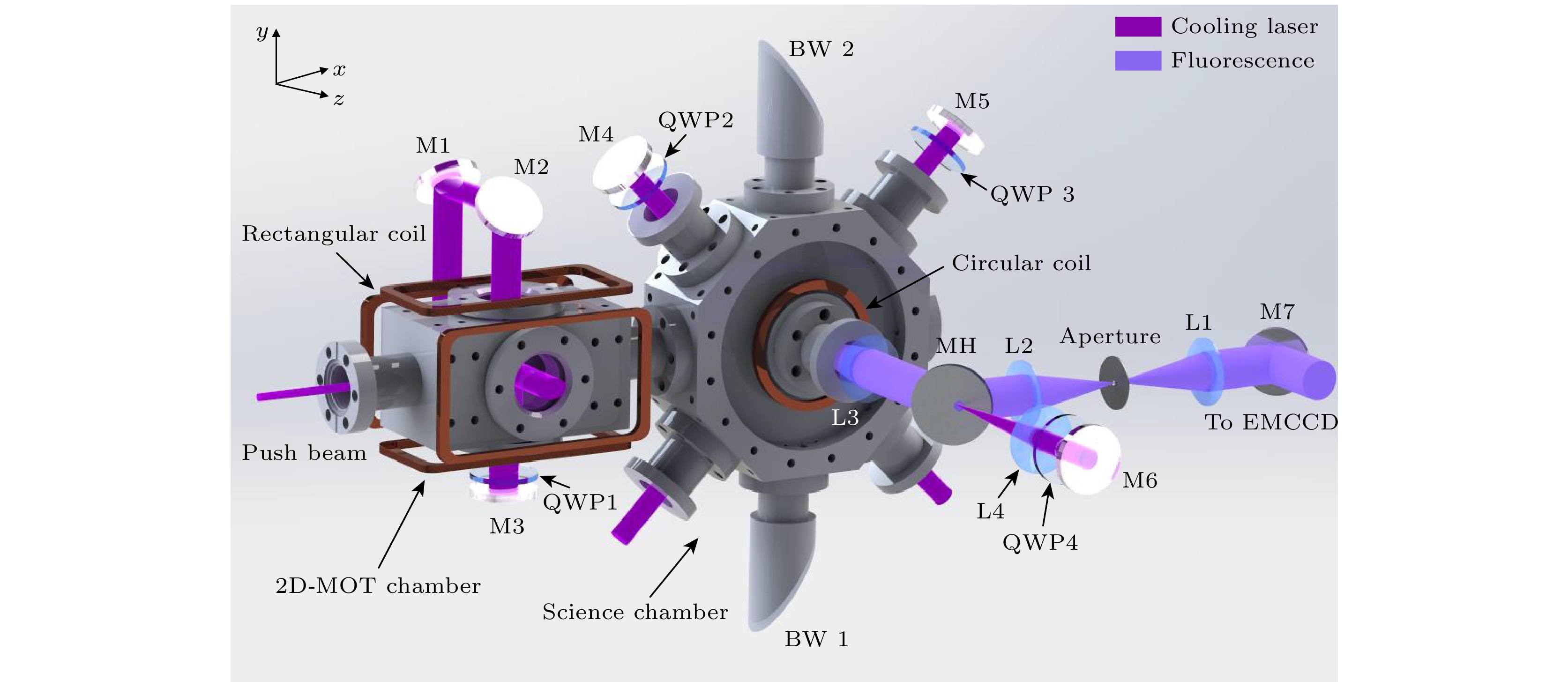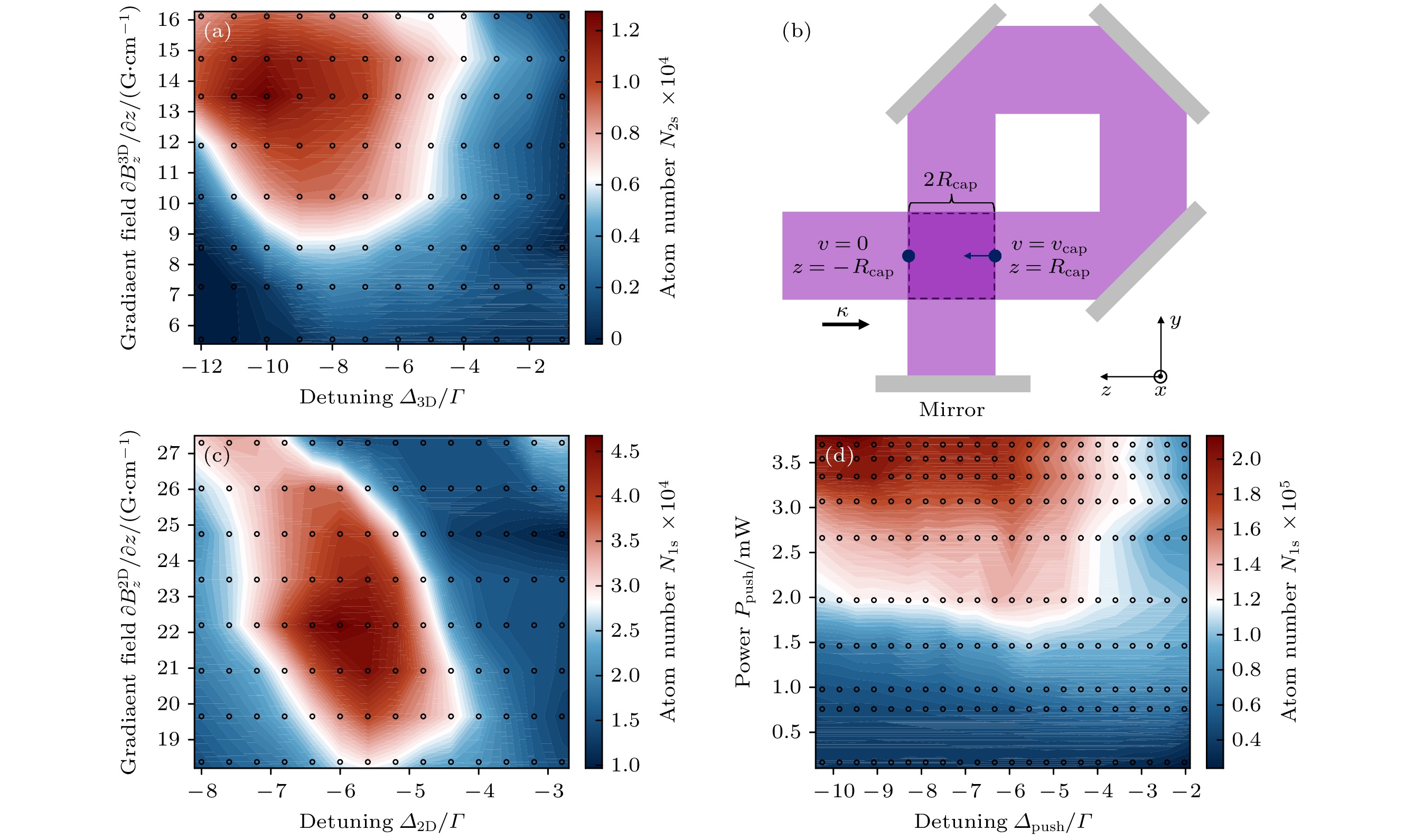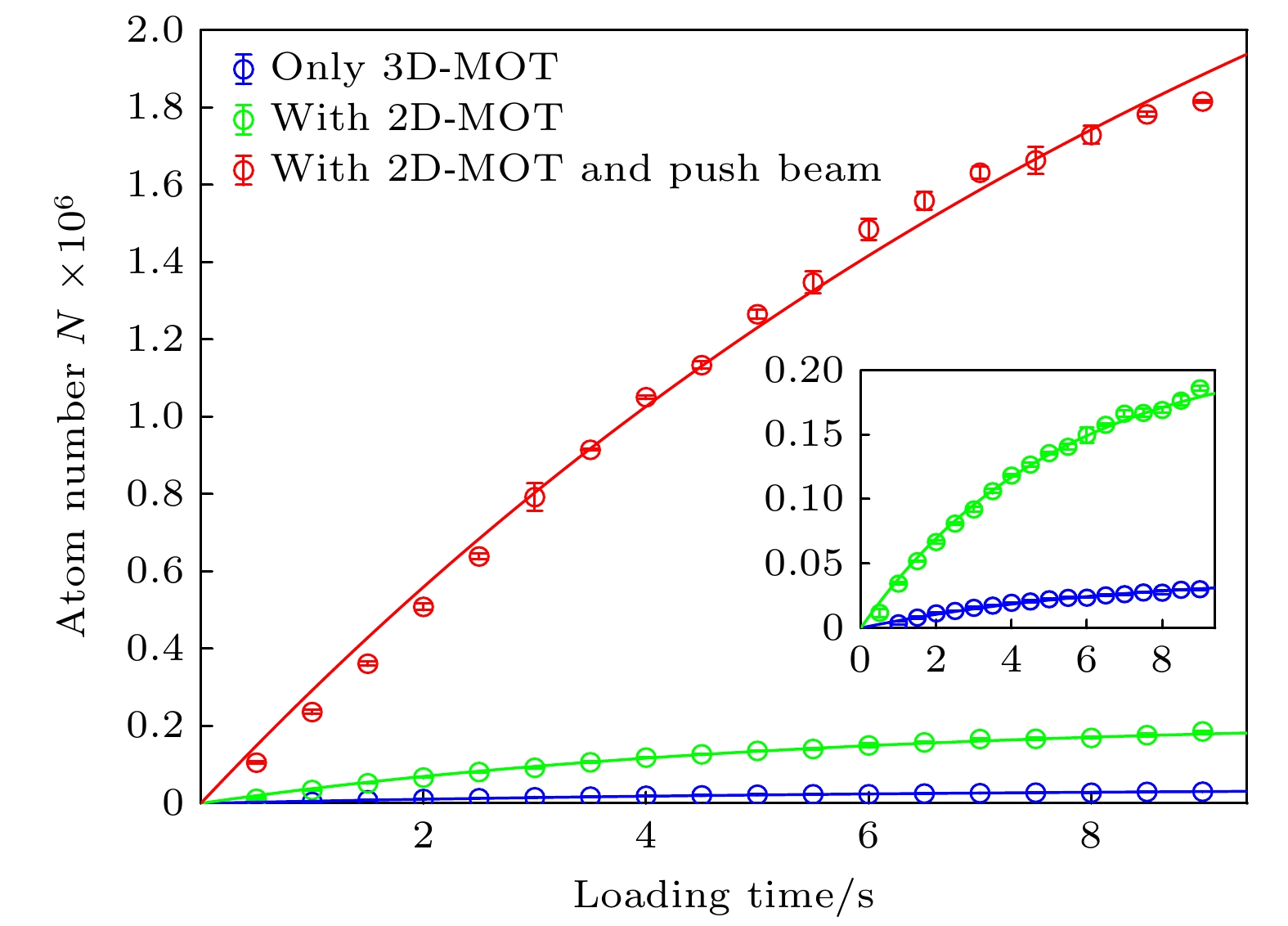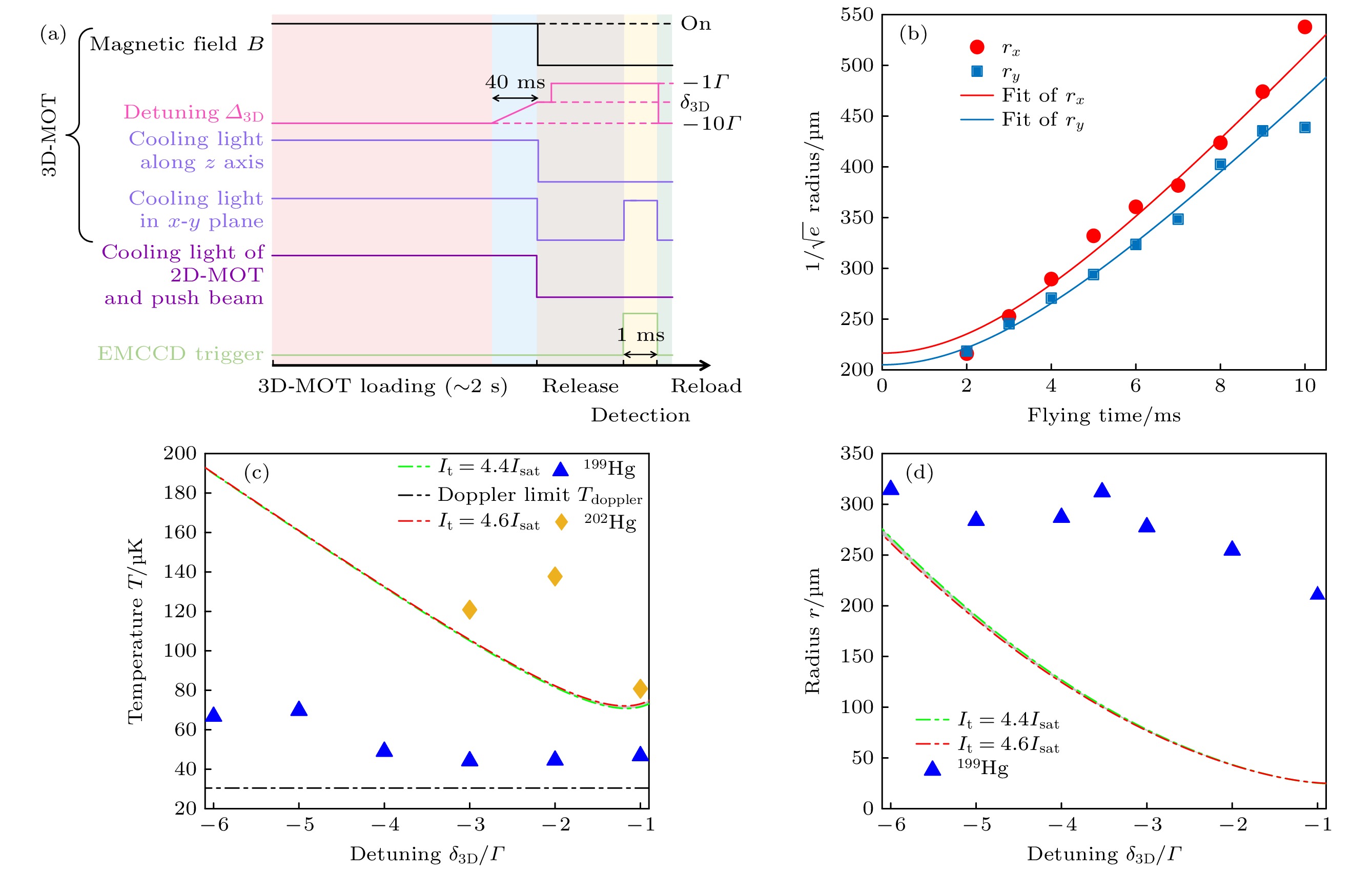-
在精密测量领域中, 高效地制备冷原子团具有重要的意义. 在光晶格钟里, 缩短冷原子团的制备时间可以降低Dick噪声, 从而提高光晶格钟的稳定性. 本文采用二维磁光阱加推送光的构型提高了三维磁光阱在超高真空环境中的装载率, 并通过压缩磁光阱技术降低了原子团温度, 实现了用于199Hg光晶格钟的增强型冷原子团制备. 实验上通过优化三维和二维磁光阱的失谐量和磁场梯度以及推送光的失谐量和功率等参数, 将三维磁光阱的199Hg冷原子装载率增强了51倍, 提升至3.1×105 s–1, 然后使用压缩磁光阱技术将199Hg冷原子团的温度降低至45 μK, 低于多普勒冷却理论温度. 这种基于二维磁光阱的增强型冷原子团制备可在超真空环境下实现对三维磁光阱装载率的高增益, 有效地缩短了冷原子团的制备时间, 同时也降低了原子团的温度, 有利于提高光晶格的转移效率, 为其他冷原子实验中冷汞原子团制备提供了有效方案.Efficient preparation of cold atoms plays an important role in realizing precision measurement including optical lattice clocks (OLCs). Fast preparation of cold atoms reduces Dick noise by shortening dead time in a clock interrogation cycle, which improves the stability of OLCs. Here, we increase the loading rate of the three-dimensional magneto-optical trap (3D-MOT) in the ultra-high vacuum environment by utilizing the two-dimensional magneto-optical trap (2D-MOT) with a push beam, reduce the temperature of cold atoms with the compression-MOT technique which is implemented by reducing the detuning of 3D-MOT rapidly at the end of atom preparation, and realize the enhanced production of cold atoms for 199Hg OLCs. To achieve 3D-MOT and 2D-MOT of mercury atoms, a deep ultraviolet laser (DUVL) system composed of three DUVLs is developed with one working in lower power for frequency locking and the other two in high power for laser cooling. Such a configuration improves the long-term frequency stability and shows greater robustness than our previous system consisting of two DUVLs. To maximize the 3D-MOT loading rate, we orderly optimize the detuning and the magnetic field gradient of 3D-MOT and those of 2D-MOT as well as the detuning and the power of the push beam. After all parameters are optimized, we measure the maximum loading rate of 3D-MOT to be 3.1×105 s–1 and prepare cold atoms of 1.8×106 in 9 s. The loading rate is greatly enhanced by a factor of 51 by using 2D-MOT and the push beam. In order to improve the efficiency of transferring cold atoms from 3D-MOT to optical lattice, we use compression-MOT technique to reduce the temperature of cold atoms and produce cold 199Hg atoms which are about 45 μK, lower than the expected temperature of Doppler cooling theory. By achieving the high gain of the 3D-MOT loading rate under the ultra-high vacuum and reducing the temperature of cold atoms, this enhanced preparation of cold atoms based on 2D-MOT effectively shortens the preparation time of cold atoms and improves the transfer efficiency of optical lattice, which provides a significant scheme for efficiently preparing cold mercury atoms in other experiments.
-
Keywords:
- mercury atom /
- optical lattice clock /
- laser cooling /
- two-dimensional magneto-optical trap
[1] Gross C, Bloch I 2017 Science 357 995
 Google Scholar
Google Scholar
[2] Bloch I, Dalibard J, Nascimbène S 2012 Nat. Phys. 8 267
 Google Scholar
Google Scholar
[3] Bloch I, Dalibard J, Zwerger W 2008 Rev. Mod. Phys. 80 885
 Google Scholar
Google Scholar
[4] Zheng T A, Yang Y A, Wang S Z, Singh J T, Xiong Z X, Xia T, Lu Z T 2022 Phys. Rev. Lett. 129 083001
 Google Scholar
Google Scholar
[5] Zheng X, Dolde J, Lochab V, Merriman B N, Li H, Kolkowitz S 2022 Nature 602 425
 Google Scholar
Google Scholar
[6] Schioppo M, Brown R C, McGrew W F, Hinkley N, Fasano R J, Beloy K, Yoon T H, Milani G, Nicolodi D, Sherman J A, Phillips N B, Oates C W, Ludlow A D 2017 Nat. Photonics 11 48
 Google Scholar
Google Scholar
[7] Al-Masoudi A, Dörscher S, Häfner S, Sterr U, Lisdat C 2015 Phys. Rev. A 92 063814
 Google Scholar
Google Scholar
[8] 卢晓同, 常宏 2022 光学学报 42 0327004
 Google Scholar
Google Scholar
Lu X T, Chang H 2022 Acta Opt. Sin. 42 0327004
 Google Scholar
Google Scholar
[9] Phillips W D, Metcalf H 1982 Phys. Rev. Lett. 48 596
 Google Scholar
Google Scholar
[10] Dieckmann K, Spreeuw R J C, Weidemüller M, Walraven J T M 1998 Phys. Rev. A 58 3891
 Google Scholar
Google Scholar
[11] Reinaudi G, Osborn C B, Bega K, Zelevinsky T 2012 J. Opt. Soc. Am. B: Opt. Phys. 29 729
 Google Scholar
Google Scholar
[12] Jallageas A, Devenoges L, Petersen M, Morel J, Bernier L G, Schenker D, Thomann P, Südmeyer T 2018 Metrologia 55 366
 Google Scholar
Google Scholar
[13] Müller T, Wendrich T, Gilowski M, Jentsch C, Rasel E M, Ertmer W 2007 Phys. Rev. A 76 063611
 Google Scholar
Google Scholar
[14] Nosske I, Couturier L, Hu F, Tan C, Qiao C, Blume J, Jiang Y H, Chen P, Weidemüller M 2017 Phys. Rev. A 96 053415
 Google Scholar
Google Scholar
[15] Schreck F, Druten K V 2021 Nat. Phys. 17 1296
 Google Scholar
Google Scholar
[16] Guo C L, Cambier V, Calvert J, Favier M, Andia M, de Sarlo L, Bize S 2023 Phys. Rev. A 107 033116
 Google Scholar
Google Scholar
[17] Zhang Y, Liu Q X, Sun J F, Xu Z, Wang Y Z 2022 Chin. Phys. B 31 073701
 Google Scholar
Google Scholar
[18] 李子亮, 师振莲, 王鹏军 2020 物理学报 69 126701
 Google Scholar
Google Scholar
Li Z L, Shi Z L, Wang P J 2020 Acta Phys. Sin. 69 126701
 Google Scholar
Google Scholar
[19] Yang J L, Long Y, Gao W W, Jin L, Zuo Z C, Wang R Q 2018 Chin. Phys. Lett 35 033701
 Google Scholar
Google Scholar
[20] Park S J, Noh J, Mun J 2012 Opt. Commun. 285 3950
 Google Scholar
Google Scholar
[21] Barbiero M, Tarallo M G, Calonico D, Levi F, Lamporesi G, Ferrari G 2020 Phys. Rev. Appl. 13 014013
 Google Scholar
Google Scholar
[22] Li K, Zhang D F, Gao T Y, Peng S G, Jiang K J 2015 Phys. Rev. A 92 013419
 Google Scholar
Google Scholar
[23] Hachisu H, Miyagishi K, Porsev S G, Derevianko A, Ovsiannikov V D, Pal’chikov V G, Takamoto M, Katori H 2008 Phys. Rev. Lett. 100 053001
 Google Scholar
Google Scholar
[24] Angstmann E J, Dzuba V A, Flambaum V V 2004 Phys. Rev. A 70 014102
 Google Scholar
Google Scholar
[25] Chupp T E, Fierlinger P, Ramsey-Musolf M J, Singh J T 2019 Rev. Mod. Phys. 91 015001
 Google Scholar
Google Scholar
[26] Tyumenev R, Favier M, Bilicki S, Bookjans E, Le Targat R, Lodewyck J, Nicolodi D, Le Coq Y, Abgrall M, Guena J, De Sarlo L, Bize S 2016 New J. Phys. 18 113002
 Google Scholar
Google Scholar
[27] Yamanaka K, Ohmae N, Ushijima I, Takamoto M, Katori H 2015 Phys. Rev. Lett. 114 230801
 Google Scholar
Google Scholar
[28] McFerran J J, Yi L, Mejri S, Bize S 2010 Opt. Lett. 35 3078
 Google Scholar
Google Scholar
[29] 刘琪鑫, 张晔, 孙剑芳, 徐震 2023 中国激光 50 0701003
 Google Scholar
Google Scholar
Liu Q X, Zhang Y, Sun J F, Xu Z 2023 Chin. J. Lasers 50 0701003
 Google Scholar
Google Scholar
[30] Liu H L, Yin S Q, Liu K K, Qian J, Xu Z, Hong T, Wang Y Z 2013 Chin. Phys. B 22 043701
 Google Scholar
Google Scholar
[31] 苟维, 刘亢亢, 付小虎, 赵儒臣, 孙剑芳, 徐震 2016 物理学报 65 130201
 Google Scholar
Google Scholar
Gou W, Liu K K, Fu X H, Zhao R C, Sun J F, Xu Z 2016 Acta Phys. Sin. 65 130201
 Google Scholar
Google Scholar
[32] Lavigne Q, Groh T, Stellmer S 2022 Phys. Rev. A 105 033106
 Google Scholar
Google Scholar
[33] 吴长江, 阮军, 陈江, 张辉, 张首刚 2013 物理学报 62 063201
 Google Scholar
Google Scholar
Wu C J, Ruan J, Chen J, Zhang H, Zhang S G 2013 Acta Phys. Sin. 62 063201
 Google Scholar
Google Scholar
[34] Jin S W, Gao J S, Chandrashekara K, Golzhauser C, Schoner J, Chomaz L 2023 Phys. Rev. A 108 023719
 Google Scholar
Google Scholar
[35] Dörscher S, Thobe A, Hundt B, Kochanke A, Le Targat R, Windpassinger P, Becker C, Sengstock K 2013 Rev. Sci. Instrum. 84 043109
 Google Scholar
Google Scholar
[36] Watson R S, McFerran J J 2021 J. Opt. Soc. Am. B: Opt. Phys. 38 36
 Google Scholar
Google Scholar
[37] Lett P D, Phillips W D, Rolston S L, Tanner C E, Watts R N, Westbrook C I 1989 J. Opt. Soc. Am. B: Opt. Phys 6 2084
 Google Scholar
Google Scholar
[38] Bjorkholm J E 1988 Phys. Rev. A 38 1599
 Google Scholar
Google Scholar
[39] Savard T A, O’Hara K M, Thomas J E 1997 Phys. Rev. A 56 R1095
 Google Scholar
Google Scholar
[40] Aldossary O M 2014 J. King Saud Univ. Sci. 26 29
 Google Scholar
Google Scholar
[41] Arpornthip T, Sackett C A, Hughes K J 2012 Phys. Rev. A 85 033420
 Google Scholar
Google Scholar
-
图 1 深紫外激光系统示意图. (DUVL, 深紫外激光器; AOM, 声光调制器; ECDL, 外腔半导体激光器; OPLL, 光学锁相环; SHG, 二次谐波产生; FMS, 调制频率光谱; FA, 光纤放大器; BS, 分束器; PD, 光电二极管; PMF, 保偏光纤; BBO, 偏硼酸钡晶体; QWP, 1/4波片)
Fig. 1. Diagram of deep ultraviolet laser system. (DUVL, deep-ultraviolet laser; AOM, acousto-optic modulator; ECDL, external cavity semiconductor laser; OPLL, optical phase-locked loop; SHG, second harmonic generation; FMS, frequency modulation spectroscopy; FA, fiber amplifier; BS, beam splitter; PD, photodiode; PMF, polarization-maintaining fiber; BBO, BaB2O4; QWP, quarter-wave plate).
图 3 (a) 2 s内装载的原子数$ {{N}}_{\text{2s}} $随3D-MOT失谐量$ {{\varDelta }}_{\text{3D}} $与磁场梯度$ \partial{{B}}_{{z}}^{\text{3D}}/\partial{z} $的变化; (b) 2D-MOT横向冷却原子示意图; (c) 1 s内装载的原子数$ {{N}}_{\text{1s}} $随2D-MOT失谐量$ {{\varDelta }}_{\text{2D}} $与磁场梯度$ \partial{{B}}_{{z}}^{\text{2D}}/\partial{z} $的变化; (d) 1 s内装载的原子数$ {{N}}_{\text{1s}} $随推送光的失谐量$ {{\varDelta }}_{\text{push}} $与功率$ {{P}}_{\text{push}} $的变化
Fig. 3. (a) Atom number $ {{N}}_{\text{2s}} $ loaded in 2 s varying with detuning $ {{\varDelta }}_{\text{3D}} $ and magnetic gradient field $ \partial{{B}}_{{z}}^{\text{3D}}/\partial{z} $ of 3D-MOT; (b) sketch of 2D-MOT capture process in the transverse direction; (c) atom number $ {{N}}_{\text{1s}} $ loaded in 1 s changing with detuning $ {{\varDelta }}_{\text{2D}} $and magnetic gradient field $ \partial{{B}}_{{z}}^{\text{2D}}/\partial{z} $ of 2D-MOT; (d) atom number $ {{N}}_{\text{1s}} $ loaded in 1 s changing with detuning $ {{\varDelta }}_{\text{push}} $ and power $ {{P}}_{\text{push}} $ of push beam.
图 5 (a) 压缩磁光阱相关时序; (b) 在失谐量$ {\delta}_{\text{3D}}=-{ \varGamma } $时原子团半径随飞行时间的变化; (c) 原子团温度随失谐量$ {\delta}_{\text{3D}} $的变化; (d) 原子团半径随失谐量$ {\delta}_{\text{3D}} $的变化
Fig. 5. (a) Relevant time sequence of compressing MOT; (b) radius of cold atoms varying with flying time at detuning $ {\delta}_{\text{3D}} $ = $ -{ \varGamma } $; (c) temperature of cold atoms varying with detuning $ {\delta}_{\text{3D}} $; (d) radius of cold atoms varying with detuning $ {\delta}_{\text{3D}} $.
-
[1] Gross C, Bloch I 2017 Science 357 995
 Google Scholar
Google Scholar
[2] Bloch I, Dalibard J, Nascimbène S 2012 Nat. Phys. 8 267
 Google Scholar
Google Scholar
[3] Bloch I, Dalibard J, Zwerger W 2008 Rev. Mod. Phys. 80 885
 Google Scholar
Google Scholar
[4] Zheng T A, Yang Y A, Wang S Z, Singh J T, Xiong Z X, Xia T, Lu Z T 2022 Phys. Rev. Lett. 129 083001
 Google Scholar
Google Scholar
[5] Zheng X, Dolde J, Lochab V, Merriman B N, Li H, Kolkowitz S 2022 Nature 602 425
 Google Scholar
Google Scholar
[6] Schioppo M, Brown R C, McGrew W F, Hinkley N, Fasano R J, Beloy K, Yoon T H, Milani G, Nicolodi D, Sherman J A, Phillips N B, Oates C W, Ludlow A D 2017 Nat. Photonics 11 48
 Google Scholar
Google Scholar
[7] Al-Masoudi A, Dörscher S, Häfner S, Sterr U, Lisdat C 2015 Phys. Rev. A 92 063814
 Google Scholar
Google Scholar
[8] 卢晓同, 常宏 2022 光学学报 42 0327004
 Google Scholar
Google Scholar
Lu X T, Chang H 2022 Acta Opt. Sin. 42 0327004
 Google Scholar
Google Scholar
[9] Phillips W D, Metcalf H 1982 Phys. Rev. Lett. 48 596
 Google Scholar
Google Scholar
[10] Dieckmann K, Spreeuw R J C, Weidemüller M, Walraven J T M 1998 Phys. Rev. A 58 3891
 Google Scholar
Google Scholar
[11] Reinaudi G, Osborn C B, Bega K, Zelevinsky T 2012 J. Opt. Soc. Am. B: Opt. Phys. 29 729
 Google Scholar
Google Scholar
[12] Jallageas A, Devenoges L, Petersen M, Morel J, Bernier L G, Schenker D, Thomann P, Südmeyer T 2018 Metrologia 55 366
 Google Scholar
Google Scholar
[13] Müller T, Wendrich T, Gilowski M, Jentsch C, Rasel E M, Ertmer W 2007 Phys. Rev. A 76 063611
 Google Scholar
Google Scholar
[14] Nosske I, Couturier L, Hu F, Tan C, Qiao C, Blume J, Jiang Y H, Chen P, Weidemüller M 2017 Phys. Rev. A 96 053415
 Google Scholar
Google Scholar
[15] Schreck F, Druten K V 2021 Nat. Phys. 17 1296
 Google Scholar
Google Scholar
[16] Guo C L, Cambier V, Calvert J, Favier M, Andia M, de Sarlo L, Bize S 2023 Phys. Rev. A 107 033116
 Google Scholar
Google Scholar
[17] Zhang Y, Liu Q X, Sun J F, Xu Z, Wang Y Z 2022 Chin. Phys. B 31 073701
 Google Scholar
Google Scholar
[18] 李子亮, 师振莲, 王鹏军 2020 物理学报 69 126701
 Google Scholar
Google Scholar
Li Z L, Shi Z L, Wang P J 2020 Acta Phys. Sin. 69 126701
 Google Scholar
Google Scholar
[19] Yang J L, Long Y, Gao W W, Jin L, Zuo Z C, Wang R Q 2018 Chin. Phys. Lett 35 033701
 Google Scholar
Google Scholar
[20] Park S J, Noh J, Mun J 2012 Opt. Commun. 285 3950
 Google Scholar
Google Scholar
[21] Barbiero M, Tarallo M G, Calonico D, Levi F, Lamporesi G, Ferrari G 2020 Phys. Rev. Appl. 13 014013
 Google Scholar
Google Scholar
[22] Li K, Zhang D F, Gao T Y, Peng S G, Jiang K J 2015 Phys. Rev. A 92 013419
 Google Scholar
Google Scholar
[23] Hachisu H, Miyagishi K, Porsev S G, Derevianko A, Ovsiannikov V D, Pal’chikov V G, Takamoto M, Katori H 2008 Phys. Rev. Lett. 100 053001
 Google Scholar
Google Scholar
[24] Angstmann E J, Dzuba V A, Flambaum V V 2004 Phys. Rev. A 70 014102
 Google Scholar
Google Scholar
[25] Chupp T E, Fierlinger P, Ramsey-Musolf M J, Singh J T 2019 Rev. Mod. Phys. 91 015001
 Google Scholar
Google Scholar
[26] Tyumenev R, Favier M, Bilicki S, Bookjans E, Le Targat R, Lodewyck J, Nicolodi D, Le Coq Y, Abgrall M, Guena J, De Sarlo L, Bize S 2016 New J. Phys. 18 113002
 Google Scholar
Google Scholar
[27] Yamanaka K, Ohmae N, Ushijima I, Takamoto M, Katori H 2015 Phys. Rev. Lett. 114 230801
 Google Scholar
Google Scholar
[28] McFerran J J, Yi L, Mejri S, Bize S 2010 Opt. Lett. 35 3078
 Google Scholar
Google Scholar
[29] 刘琪鑫, 张晔, 孙剑芳, 徐震 2023 中国激光 50 0701003
 Google Scholar
Google Scholar
Liu Q X, Zhang Y, Sun J F, Xu Z 2023 Chin. J. Lasers 50 0701003
 Google Scholar
Google Scholar
[30] Liu H L, Yin S Q, Liu K K, Qian J, Xu Z, Hong T, Wang Y Z 2013 Chin. Phys. B 22 043701
 Google Scholar
Google Scholar
[31] 苟维, 刘亢亢, 付小虎, 赵儒臣, 孙剑芳, 徐震 2016 物理学报 65 130201
 Google Scholar
Google Scholar
Gou W, Liu K K, Fu X H, Zhao R C, Sun J F, Xu Z 2016 Acta Phys. Sin. 65 130201
 Google Scholar
Google Scholar
[32] Lavigne Q, Groh T, Stellmer S 2022 Phys. Rev. A 105 033106
 Google Scholar
Google Scholar
[33] 吴长江, 阮军, 陈江, 张辉, 张首刚 2013 物理学报 62 063201
 Google Scholar
Google Scholar
Wu C J, Ruan J, Chen J, Zhang H, Zhang S G 2013 Acta Phys. Sin. 62 063201
 Google Scholar
Google Scholar
[34] Jin S W, Gao J S, Chandrashekara K, Golzhauser C, Schoner J, Chomaz L 2023 Phys. Rev. A 108 023719
 Google Scholar
Google Scholar
[35] Dörscher S, Thobe A, Hundt B, Kochanke A, Le Targat R, Windpassinger P, Becker C, Sengstock K 2013 Rev. Sci. Instrum. 84 043109
 Google Scholar
Google Scholar
[36] Watson R S, McFerran J J 2021 J. Opt. Soc. Am. B: Opt. Phys. 38 36
 Google Scholar
Google Scholar
[37] Lett P D, Phillips W D, Rolston S L, Tanner C E, Watts R N, Westbrook C I 1989 J. Opt. Soc. Am. B: Opt. Phys 6 2084
 Google Scholar
Google Scholar
[38] Bjorkholm J E 1988 Phys. Rev. A 38 1599
 Google Scholar
Google Scholar
[39] Savard T A, O’Hara K M, Thomas J E 1997 Phys. Rev. A 56 R1095
 Google Scholar
Google Scholar
[40] Aldossary O M 2014 J. King Saud Univ. Sci. 26 29
 Google Scholar
Google Scholar
[41] Arpornthip T, Sackett C A, Hughes K J 2012 Phys. Rev. A 85 033420
 Google Scholar
Google Scholar
计量
- 文章访问数: 5296
- PDF下载量: 144
- 被引次数: 0













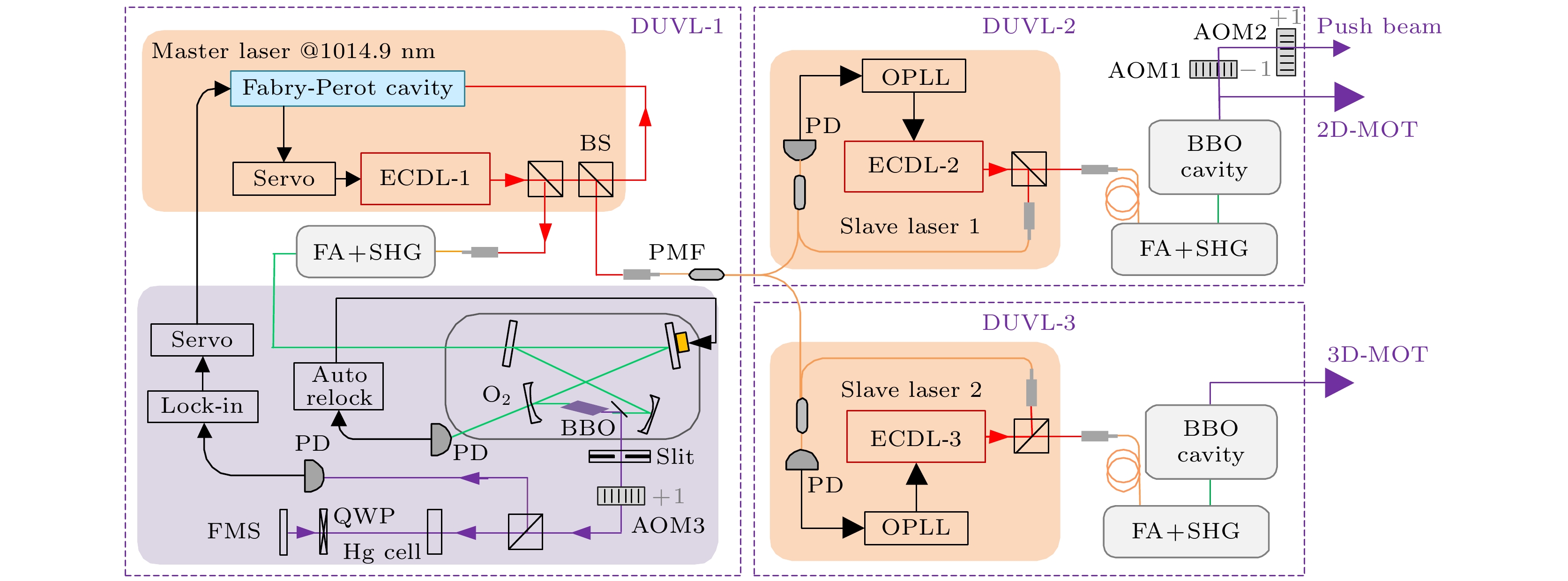
 下载:
下载:
